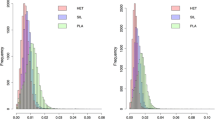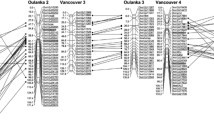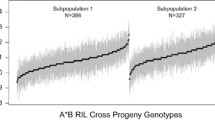Abstract
The Hawaiian picture-winged flies in the genus Drosophila are a spectacular example of rapid evolutionary diversification in which sexual selection is considered an important mechanism for reproductive isolation and speciation. We investigated the behavioral reproductive isolation of two closely related and sympatric Hawaiian picture-winged Drosophila species, D. silvestris and D. heteroneura, which are known to hybridize in nature and produce viable and fertile hybrids. We compared the mating success of parental, F1 and backcross males in pairings with D. heteroneura females. The F1 males were produced by mating D. heteroneura males with D. silvestris females, and the backcross males were produced by mating F1 females with D. heteroneura males. The mating success of backcross males paired with D. heteroneura females were significantly reduced relative to that of parental and F1 males. This reduced mating success occurred primarily at a late stage of courtship where female choice of mate may be important. Two- and three-gene models demonstrate that epistasis involving a few genes could account for the observed variation in male mating success. These results are consistent with negative epistasis in the backcross generation and support the importance of sexual selection and negative epistasis in the evolution and maintenance of these species.



Similar content being viewed by others
References
Ahearn JN, Templeton A (1989) Interspecific hybrids of Drosophila heteroneura and D. silvestris: courtship success. Evolution 43:347–361
Alves H, Rouault J, Kondoh Y, Nakano Y, Yamamoto D, Kim Y, Jallon J (2010) Evolution of cuticular hydrocarbons of Hawaiian Drosophilidae. Behav Genet 40:694–705
Arnegard ME, Kondrashov AS (2004) Sympatric speciation by sexual selection alone is unlikely. Evolution 58:222–237
Boake CRB (2005) Sexual selection and speciation in Hawaiian Drosophila. Behav Genet 35:297–303
Boake CRB, DeAngelis MP, Andreadis DK (1997) Is sexual selection and species recognition a continuum? Mating behavior of the stalk-eyed fly Drosophila heteroneura. Proc Natl Acad Sci U S A 94:12442–12445
Boake CRB, Price DK, Andreadis DK (1998) Inheritance of behavioural differences between two interfertile, sympatric species, Drosophila silvestris and D. heteroneura. Heredity 80:642–650
Boake CRB, Andreadis DK, Witzel A (2000) Behavioural isolation between two closely related Hawaiian Drosophila species: the role of courtship. Anim Behav 60:495–501
Bolnick DI, Fitzpatrick BM (2007) Sympatric speciation: models and empirical evidence. Ann Rev Ecol Syst 38:459–487
Burke JM, Arnold ML (2001) Genetics and the fitness of hybrids. Ann Rev Genet 35:31–52
Carlborg O, Haley C (2004) Epistasis: too often neglected in complex trait studies? Nat Rev 5:618–625
Carson HL (1982) Evolution of Drosophila on the newer Hawaiian volcanoes. Heredity 48:3–25
Carson HL (1987) High fitness of heterokaryotipic individuals segregating naturally within a long-standing laboratory population of Drosophila silvestris. Genetics 116:415–422
Carson HL (1997) Sexual selection: a driver of genetic change in Hawaiian Drosophila. J Heredity 88:343–352
Carson HL, Clague DA (1995) Geology and biogeography of the Hawaiian Islands. In: Wagner W, Funk V (eds) Hawaiian biogeography: evolution in a hotspot archipelago. Smithsonian Institution Press, Washington, DC, pp 14–29
Carson HL, Kaneshiro KY (1976) Drosophila of Hawaii: systematics and ecological genetics. Ann Rev Ecol Syst 7:311–345
Carson HL, Templeton AR (1984) Genetic revolutions in relation to speciation phenomena: the founding of new populations. Ann Rev Ecol Syst 15:97–131
Carson HL, Kaneshiro KY, Val FC (1989) Natural hybridization between the sympatric Hawaiian species Drosophila silvestris and Drosophila heteroneura. Evolution 43:190–203
Carson HL, Val FC, Templeton AR (1994) Change in male secondary sexual characters in artificial interspecific hybrid populations. Proc Natl Acad Sci U S A 91:6315–6318
Coyne JA, Orr HA (2004) Speciation. Sinauer Associates, Sunderland
Craddock EM (1974) Reproductive relationships between homsequential species of Hawaiian Drosophila. Evolution 28:593–606
Darwin C (1859) The origin of species by means of natural selection. John Murray, London
DeSalle R, Brower AVZ (1997) Process partitions, congruence, and the independence of characters: inferring relationships among closely related Hawaiian Drosophila from multiple gene regions. Syst Biol 46:751–764
Dobzhansky T (1937) Genetics and the origin of species. Columbia Univ. Press, New York
Fiston-Lavier A-S, Singh ND, Lipatov M, Petrov DA (2010) Drosophila melanogaster recombination rate calculator. Gene 463:18–20
Gavrilets S (2004) Fitness landscapes and the origin of species. Princeton University Press, Princeton
Gavrilets S, Losos JB (2009) Adaptive radiation: contrasting theory with data. Science 323:732–737
Grace JL, Shaw KL (2012) Incipient sexual isolation in Laupala cerasina: females discriminate population-level divergence in acoustic characters. Curr Zool 58:416–425
Hoikkala A, Kaneshiro KY (1993) Change in the signal-response sequence responsible for asymmetric isolation between Drosophila planitibia and Drosophila silvestris. Proc Natl Acad Sci U S A 90:5813–5817
Huanga W, Richards S, Carbonea MA, Zhub D, Anholtc RRH, Ayrolesa JF, Duncan L, Jordana KW, Lawrence F, Magwire MM, Warner CB, Blankenburg K, Han Y, Javaid M, Jayaseelan J, Jhangiani SN, Muzny D, Ongeri F, Perales L, Wu Y-Q, Zhang Y, Zoub X, Stone EA, Gibbs RA, Mackay TFC (2012) Epistasis dominates the genetic architecture of Drosophila quantitative traits. PNAS 109:15553–15559
Kaneshiro KY (1976) Ethological isolation and phylogeny in the Planitibia subgroup of Hawaiian Drosophila. Evolution 30:740–745
Kaneshiro KY (1997) R.C.L. Perkins’ legacy to evolutionary research on Hawaiian Drosophilidae (Diptera). Pac Sci 51:450–461
Lande R (1981) Models of speciation by sexual selection on polygenic traits. Proc Natl Acad Sci U S A 78:7212–7725
Lapoint RT, Gidaya A, O’Grady PM (2011) Phylogenetic relationships in the spoon tarsus subgroup of Hawaiian Drosophila: conflict and concordance between gene trees. Mol Phylogenet Evol 58:492–501
Magnacca KN, Foote D, O’Grady PM (2008) A review of the endemic Hawaiian Drosophilidae and their host plants. Zootaxa 1728:1–58
Mendelson TC, Shaw KL (2012) The (mis)concept of species recognition. TREE 27:421–427
Montgomery SL (1975) Comparative breeding site ecology and the adaptive radiation of picture-winged Drosophila (Diptera: Drosophilidae) in Hawaii. Proc Hawaiian Entomol Soc 22:65–103
Muller HJ (1942) Isolating mechanisms, evolution and temperature. Biol Sympos 6:71–125
Noor MAF, Garfield DA, Schaeffer SW, Machado CA (2007) Divergence between the Drosophila pseudoobscura and D. persimilis genome sequences in relation to chromosomal inversions. Genetics 177:1417–1428
Nosil P, Schluter D (2011) The genes underlying the process of speciation. TREE 26:160–167
O’Grady PM, Magnacca KN, Lapoint RT (2010) Taxonomic relationships within the endemic Hawaiian Drosophilidae. Rec Hawaii Biol Surv 108:3–35
O’Grady PM, Lapoint RT, Bonacum J, Lasola J, Owen E, Wu Y, DeSalle R (2011) Phylogenetic and ecological relationships of the Hawaiian Drosophila inferred by mitochondrial DNA analysis. Mol Phylogenet Evol 58:244–256
Orr HA (1995) The population genetics of speciation: the evolution of hybrid incompatibilities. Genetics 139:1805–1813
Orr HA (2005) The genetic basis of reproductive isolation: insights from Drosophila. PNAS 102:6522–6526
Panhuis TM, Butlin R, Zuk M, Tregenza T (2001) Sexual selection and speciation. TREE 16:364–371
Presgraves DC (2007) Speciation genetics: epistasis, conflict and the origin of species. Curr Biol 17:125–127
Price DK, Boake CRB (1995) Behavioral reproductive isolation in Drosophila silvestris, D. heteroneura, and their F1 hybrids (Diptera: Drosophilidae). J Insect Behav 8:595–616
Ritchie MG (2007) Sexual selection and speciation. Ann Rev Ecol Evol Syst 38:79–102
Seehausen O (2000) Explosive speciation rates and unusual species richness in haplochromine cichlid fishes: effects of sexual selection. Adv Ecol Res 31:237–274
Servedio MR, Van Doorn GS, Kopp M, Frame AM, Nosil P (2011) Magic traits in speciation: ‘magic’ but not rare? TREE 26:389–397
Templeton AR (2008) The reality and importance of founder speciation in evolution. Bioessays 30:470–479
Uyeda JC, Arnold SJ, Hohenlohe PA, Mead LS (2009) Drift promotes speciation by sexual selection. Evolution 63:583–594
Val FC (1977) Genetic analysis of the morphological differences between two interfertile species of Hawaiian Drosophila. Evolution 31:611–629
Via S (2001) Sympatric speciation in animals: the ugly duckling grows up. TREE 16:381–390
Acknowledgments
We thank K.Y. Kaneshiro for providing the initial populations of Drosophila silvestris and D. heteroneura from the Hawaiian Drosophila species stock center. We thank C.R.B. Boake and for discussions regarding Hawaiian Drosophila speciation and behavior that led to the development of this project. We thank E. Stacy for extensive discussions and comments on a previous version of this manuscript. This research was supported by the University of Hawaii at Hilo and the US National Science Foundation grants HRD 0833211, EPS 0554657.
Author information
Authors and Affiliations
Corresponding author
Rights and permissions
About this article
Cite this article
Price, D.K., Souder, S.K. & Russo-Tait, T. Sexual Selection, Epistasis and Species Boundaries in Sympatric Hawaiian Picture-winged Drosophila . J Insect Behav 27, 27–40 (2014). https://doi.org/10.1007/s10905-013-9404-6
Revised:
Accepted:
Published:
Issue Date:
DOI: https://doi.org/10.1007/s10905-013-9404-6




